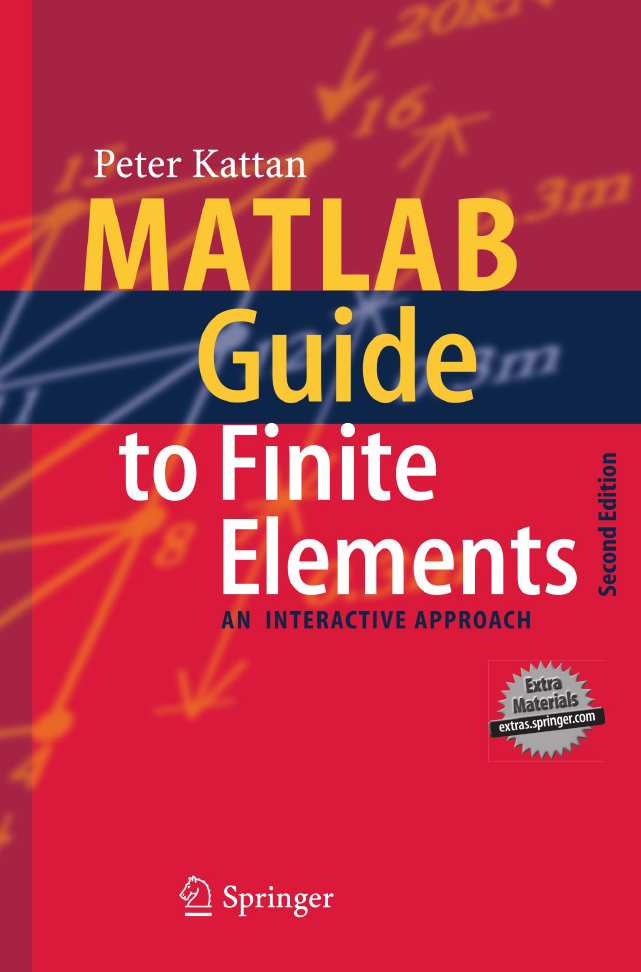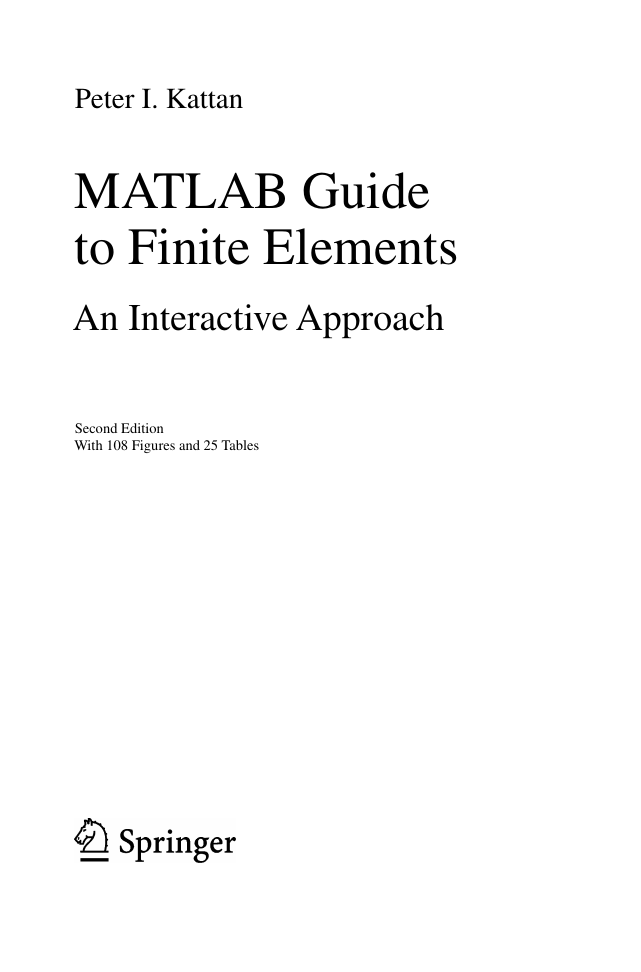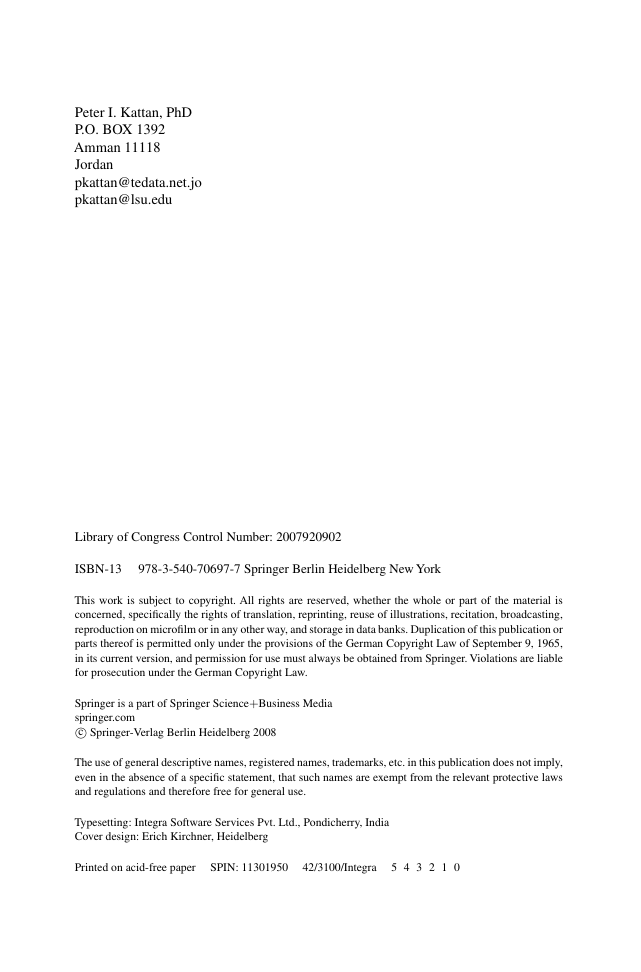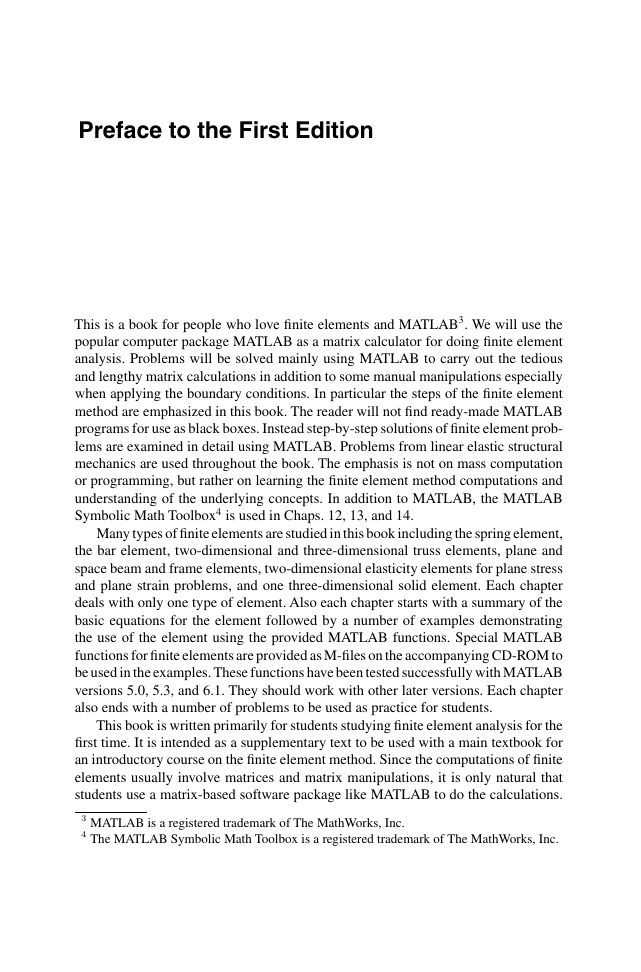�
MATLAB Guide to Finite Elements
Peter I. Kattan
MATLAB Guide
to Finite Elements
An Interactive Approach
Second Edition
With 108 Figures and 25 Tables
�
Peter I. Kattan, PhD
P.O. BOX 1392
Amman 11118
Jordan
pkattan@tedata.net.jo
pkattan@lsu.edu
Library of Congress Control Number: 2007920902
ISBN-13
978-3-540-70697-7 Springer Berlin Heidelberg New York
This work is subject to copyright. All rights are reserved, whether the whole or part of the material is
concerned, specifically the rights of translation, reprinting, reuse of illustrations, recitation, broadcasting,
reproduction on microfilm or in any other way, and storage in data banks. Duplication of this publication or
parts thereof is permitted only under the provisions of the German Copyright Law of September 9, 1965,
in its current version, and permission for use must always be obtained from Springer. Violations are liable
for prosecution under the German Copyright Law.
Springer is a part of Springer Science+Business Media
springer.com
c Springer-Verlag Berlin Heidelberg 2008
The use of general descriptive names, registered names, trademarks, etc. in this publication does not imply,
even in the absence of a specific statement, that such names are exempt from the relevant protective laws
and regulations and therefore free for general use.
Typesetting: Integra Software Services Pvt. Ltd., Pondicherry, India
Cover design: Erich Kirchner, Heidelberg
Printed on acid-free paper
SPIN: 11301950
42/3100/Integra
5 4 3 2 1 0
�
Dedicated to My Professor, George Z. Voyiadjis
�
Preface to the Second Edition
Soon after the first edition of this book was published at the end of 2002, it was
realized that a new edition of the book was needed. I received positive feedback
from my readers who requested that I provide additional finite elements in other
areas like fluid flow and heat transfer. However, I did not want to lengthen the book
considerably. Therefore, I decided to add two new chapters thus adding new material
while keeping the size of the book reasonable.
The second edition of the book continues with the same successful format that
characterized the first edition – which was sold out in less than four years. I continue
to emphasize the important features of interactivity of using MATLAB1 coupled with
the simplicity and consistency of presentation of finite elements. One of the most
important features also is bypassing the use of numerical integration in favor of exact
analytical integration with the use of the MATLAB Symbolic Math Toolbox2. The
use of this toolbox is emphasized in Chaps. 12, 13, 14, and 16.
In the new edition, two important changes are immediately noted. First, I corrected
the handful of typing errors that appeared in the first edition. Second, I added two
new chapters. Chap. 16 includes another solid three-dimensional element (the eight-
noded brick element) in great detail. The final chapter (Chap. 17) provides a review
of the applications of finite elements in other areas like fluid flow, heat transfer,
geotechnical engineering, electro-magnetics, structural dynamics, plasticity, etc. In
this chapter, I show how the same consistent strategy that was followed in the first
sixteen chapters can be used to write MATLAB functions in these areas by providing
the MATLAB code for a one-dimensional fluid flow element.
One minor drawback of the first edition as I see it is the absence of a concluding
chapter. Therefore, I decided to remedy the situation by adding Chap. 17 as a real
concluding chapter to the book. It is clear that this chapter is different from the first
sixteen chapters and thus may well provide a well written conclusion to the book.
The second edition still comes with an accompanying CD-ROM that contains the
full set of M-files written specifically to be used with this book. These MATLAB
functions have been tested with version 7 of MATLAB and should work with any
1 MATLAB is a registered trademark of The MathWorks, Inc.
2 The MATLAB Symbolic Math Toolbox is a registered trademark of The MathWorks, Inc.
�
VIII
Preface to the Second Edition
later versions. In addition, the CD-ROM contains a complete solutions manual that
includes detailed solutions to all the problems in the book. If the reader does not wish
to consult these solutions, then a brief list of answers is provided in printed form at
the end of the book.
I would like to thank my family members for their help and continued support with-
out which this book would not have been possible. I would also like to acknowledge
the help of the editior at Springer-Verlag (Dr. Thomas Ditzinger) for his assistance in
bringing this book out in its present form. Finally, I would like to thank my brother,
Nicola, for preparing most of the line drawings in both editions. In this edition, I am
providing two email addresses for my readers to contact me (pkattan@tedata.net.jo
and pkattan@lsu.edu). The old email address that appeared in the first edition was
cancelled in 2004.
December 2006
Peter I. Kattan
�
Preface to the First Edition
This is a book for people who love finite elements and MATLAB3. We will use the
popular computer package MATLAB as a matrix calculator for doing finite element
analysis. Problems will be solved mainly using MATLAB to carry out the tedious
and lengthy matrix calculations in addition to some manual manipulations especially
when applying the boundary conditions. In particular the steps of the finite element
method are emphasized in this book. The reader will not find ready-made MATLAB
programs for use as black boxes. Instead step-by-step solutions of finite element prob-
lems are examined in detail using MATLAB. Problems from linear elastic structural
mechanics are used throughout the book. The emphasis is not on mass computation
or programming, but rather on learning the finite element method computations and
understanding of the underlying concepts. In addition to MATLAB, the MATLAB
Symbolic Math Toolbox4 is used in Chaps. 12, 13, and 14.
Many types of finite elements are studied in this book including the spring element,
the bar element, two-dimensional and three-dimensional truss elements, plane and
space beam and frame elements, two-dimensional elasticity elements for plane stress
and plane strain problems, and one three-dimensional solid element. Each chapter
deals with only one type of element. Also each chapter starts with a summary of the
basic equations for the element followed by a number of examples demonstrating
the use of the element using the provided MATLAB functions. Special MATLAB
functions for finite elements are provided as M-files on the accompanying CD-ROM to
be used in the examples. These functions have been tested successfully with MATLAB
versions 5.0, 5.3, and 6.1. They should work with other later versions. Each chapter
also ends with a number of problems to be used as practice for students.
This book is written primarily for students studying finite element analysis for the
first time. It is intended as a supplementary text to be used with a main textbook for
an introductory course on the finite element method. Since the computations of finite
elements usually involve matrices and matrix manipulations, it is only natural that
students use a matrix-based software package like MATLAB to do the calculations.
3 MATLAB is a registered trademark of The MathWorks, Inc.
4 The MATLAB Symbolic Math Toolbox is a registered trademark of The MathWorks, Inc.
�
















 2023年江西萍乡中考道德与法治真题及答案.doc
2023年江西萍乡中考道德与法治真题及答案.doc 2012年重庆南川中考生物真题及答案.doc
2012年重庆南川中考生物真题及答案.doc 2013年江西师范大学地理学综合及文艺理论基础考研真题.doc
2013年江西师范大学地理学综合及文艺理论基础考研真题.doc 2020年四川甘孜小升初语文真题及答案I卷.doc
2020年四川甘孜小升初语文真题及答案I卷.doc 2020年注册岩土工程师专业基础考试真题及答案.doc
2020年注册岩土工程师专业基础考试真题及答案.doc 2023-2024学年福建省厦门市九年级上学期数学月考试题及答案.doc
2023-2024学年福建省厦门市九年级上学期数学月考试题及答案.doc 2021-2022学年辽宁省沈阳市大东区九年级上学期语文期末试题及答案.doc
2021-2022学年辽宁省沈阳市大东区九年级上学期语文期末试题及答案.doc 2022-2023学年北京东城区初三第一学期物理期末试卷及答案.doc
2022-2023学年北京东城区初三第一学期物理期末试卷及答案.doc 2018上半年江西教师资格初中地理学科知识与教学能力真题及答案.doc
2018上半年江西教师资格初中地理学科知识与教学能力真题及答案.doc 2012年河北国家公务员申论考试真题及答案-省级.doc
2012年河北国家公务员申论考试真题及答案-省级.doc 2020-2021学年江苏省扬州市江都区邵樊片九年级上学期数学第一次质量检测试题及答案.doc
2020-2021学年江苏省扬州市江都区邵樊片九年级上学期数学第一次质量检测试题及答案.doc 2022下半年黑龙江教师资格证中学综合素质真题及答案.doc
2022下半年黑龙江教师资格证中学综合素质真题及答案.doc